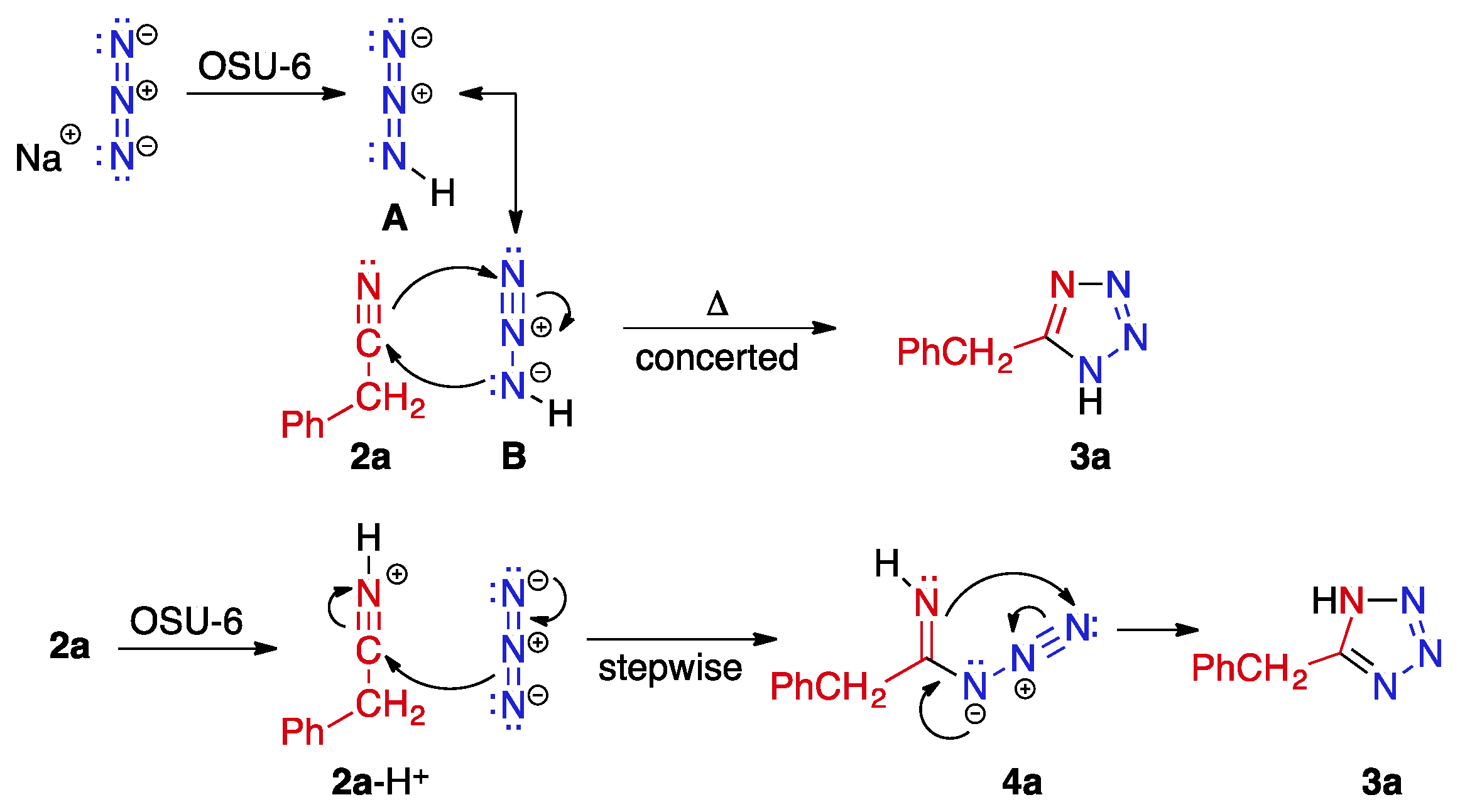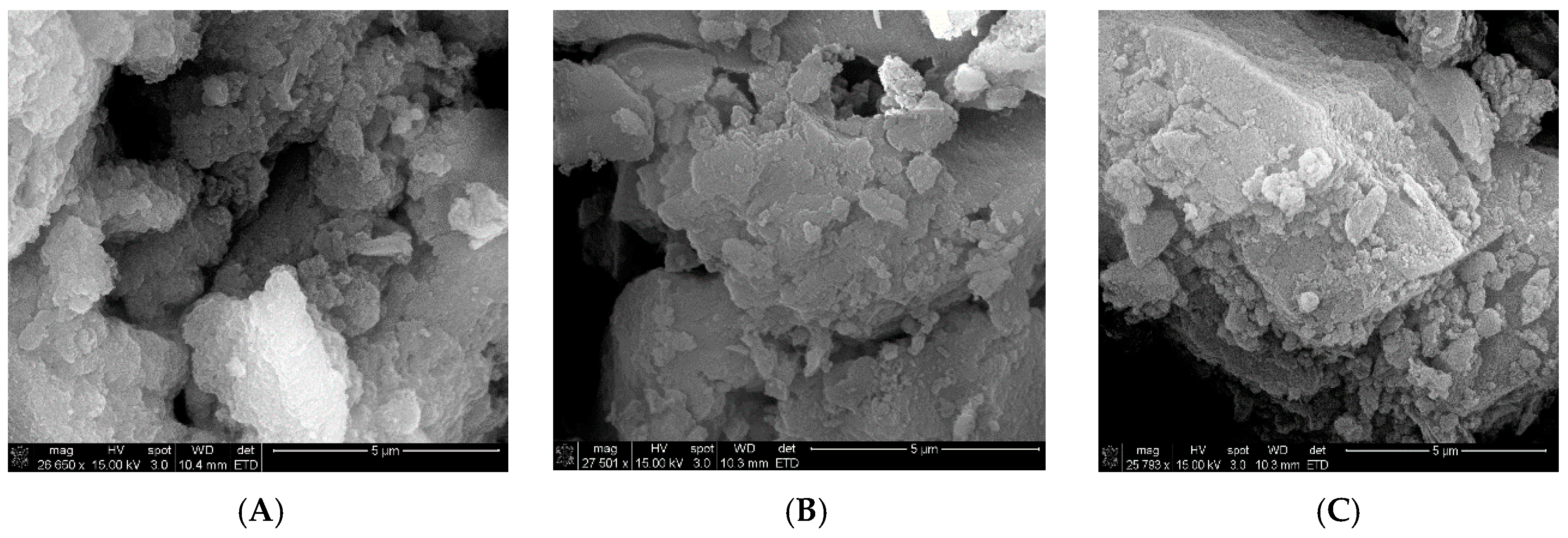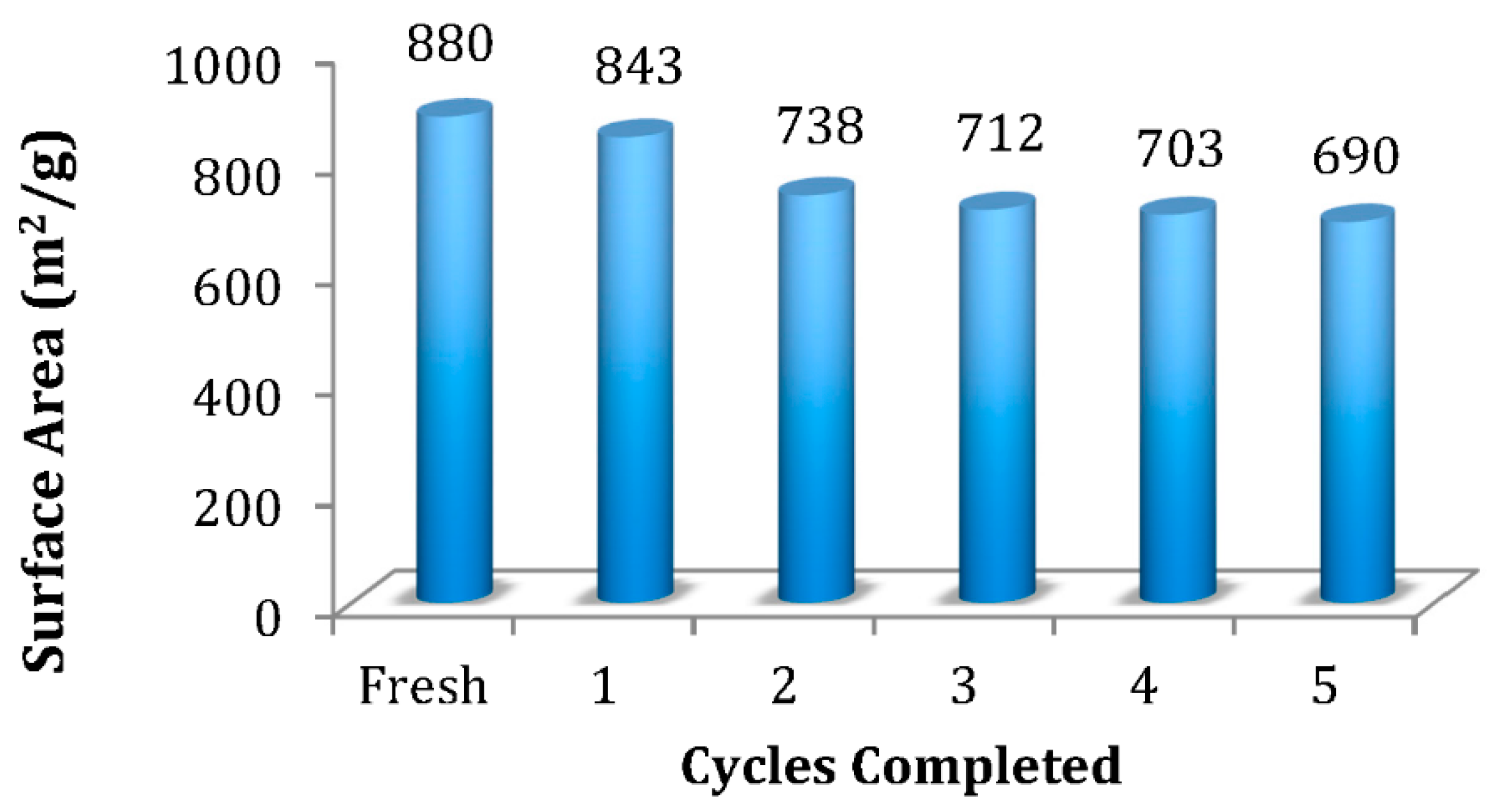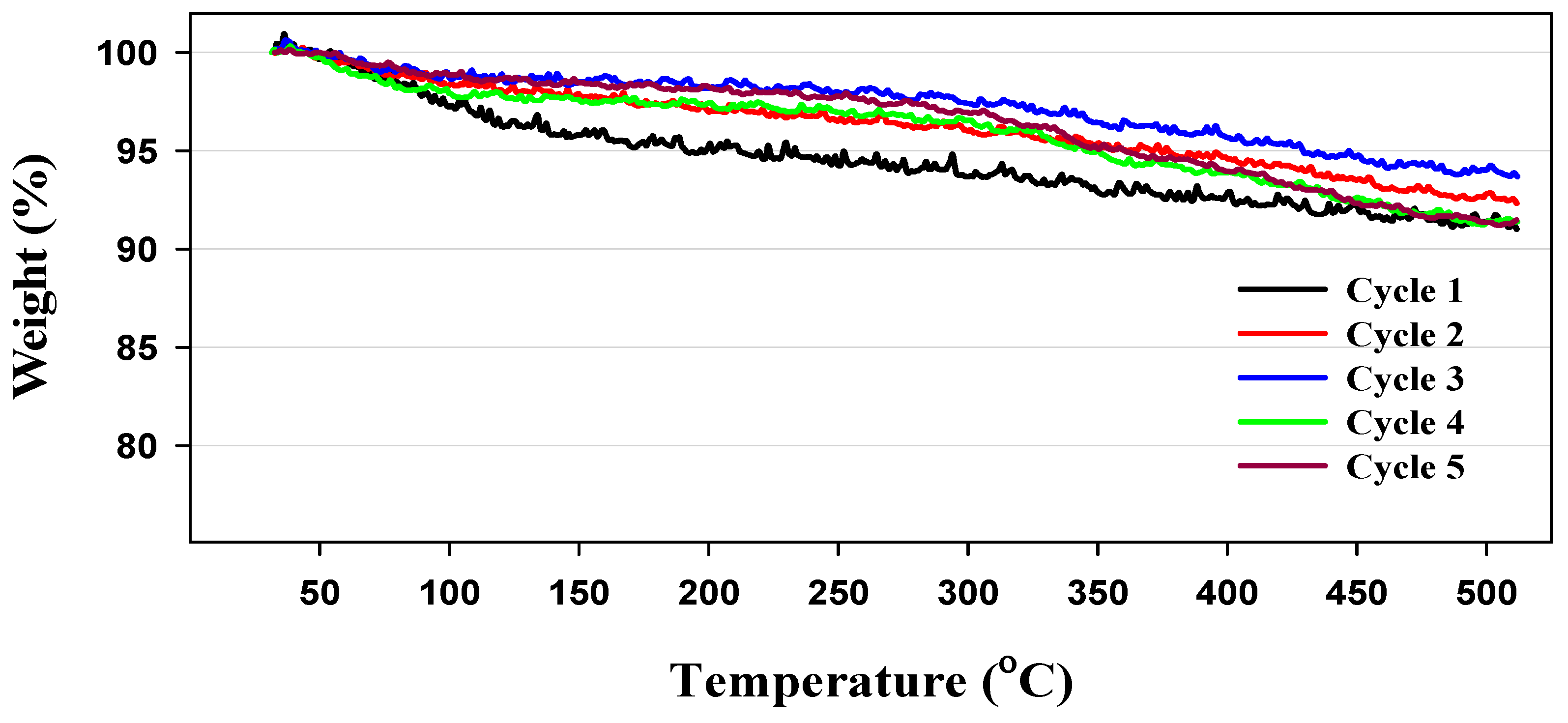OSU-6: A Highly Efficient, Metal-Free, Heterogeneous Catalyst for the Click Synthesis of 5-Benzyl and 5-Aryl-1H-tetrazoles
Abstract
:1. Introduction
2. Results and Discussion
| Entry | Solvent | OSU-6 (wt %) | Temperature (oC) | Time (h) | Isolated Yield (%) |
|---|---|---|---|---|---|
| 1 | EtOH | 15 | 90 | 12 | trace |
| 2 | CH3CN | 15 | 90 | 24 | 18 |
| 3 | dioxane | 15 | 95 | 18 | trace |
| 4 | THF | 15 | 70 | 18 | 10 |
| 5 | solventless | 15 | 120 | 6 | 76 |
| 6 | DMSO | 15 | 140 | 6 | 84 |
| 7 | DMF | 50 | 120 | 6 | 88 |
| 8 | DMF | 25 | 120 | 6 | 87 |
| 9 | DMF | 15 | 120 | 6 | 90 |
| 10 a | DMF | 15 | 90 | 4 | 94 |
| 11 | DMF | 15 | 75 | 6 | 10 |
| 12 | DMF | 10 | 90 | 6 | 73 |
| 13 | DMF | 0 | 120 | 12 | trace |
| Substrate | R | Product | Time (h) | Isolated Yield (%) |
|---|---|---|---|---|
| 1a | C6H5CH2 | 2a | 4 | 94 |
| 1b | 4-CH3C6H4CH2 | 2b | 5 | 87 |
| 1c | 4-CH3OC6H4CH2 | 2c | 4 | 92 |
| 1q | 4-ClC6H4CH2 | 2d | 5 | 90 |
| 1e | 4-FC6H4CH2 | 2e | 5 | 86 |
| 1f | C6H5 | 2f | 8 | 89 |
| 1g | 4-CH3C6H4 | 2g | 8 | 90 |
| 1h | 2-CH3C6H4 | 2h | 6 | 94 |
| 1i | 4-CH3OC6H4 | 2i | 6 | 92 |
| 1j | 4-NO2C6H4 | 2j | 12 | 84 |
| 1k | 3-NO2C6H4 | 2k | 12 | 80 |
| 1l | 4-ClC6H4 | 2l | 8 | 91 |
| 1m | 4-FC6H4 | 2m | 8 | 87 |
| 1n | (C6H5)2CH | 2n | 12 | 94 |
| 1o | 4-CH3(CH2)6C6H4 | 2o | 4 | 87 |
| 1p | 4-CH2=CH(CH2)2C6H4 | 2p | 4 | 95 |





3. Experimental Section
3.1. General Information
3.2. Representative Procedure for the Preparation of 5-Benzyl and 5-Aryl-1H-tetrazoles
4. Conclusions
Supplementary Materials
Acknowledgments
Author Contributions
Conflicts of Interest
References and Notes
- Mohite, P.B.; Bhaskar, V.H. Potential pharmacological activities of tetrazoles in the new millennium. Int. J. PharmTech Res. 2011, 3, 1557–1566. [Google Scholar]
- Ostrovskii, V.A.; Trifonov, R.E.; Popova, E.A. Medicinal chemistry of tetrazoles. Russ. Chem. Bull. 2012, 61, 768–780. [Google Scholar] [CrossRef]
- Mohammad, A. Biological potentials of substituted tetrazole compounds. Pharm. Methods 2014, 5, 39–46. [Google Scholar]
- Camilleri, P.; Kerr, M.W.; Newton, T.W.; Bowyer, J.R. Structure activity studies of tetrazole urea herbicides. J. Agric. Food Chem. 1989, 37, 196–200. [Google Scholar] [CrossRef]
- Tuites, R.C.; Whiteley, T.E.; Minsk, L.M. Polymers Containing Tetrazole Groups, Useful in Photographic Emulsions. Patent GB1245614A, 8 September 1971. [Google Scholar]
- Matyas, R.; Pachman, J. Primary Explosives; Springer: Berlin, Germany; Heidelberg, Germany, 2013; p. 338. [Google Scholar]
- An, P.; Yu, Z.; Lin, Q. Design of oligothiophene-based tetrazoles for laser-triggered photoclick chemistry in living cells. Chem. Commun. 2013, 49, 9920–9922. [Google Scholar] [CrossRef] [PubMed]
- Tariq, M.; Hameed, S.; Bechtold, I.H.; Bortoluzzi, A.J.; Merlo, A.A. Synthesis and characterization of some novel tetrazole liquid crystals. J. Mater. Chem. C 2013, 1, 5583–5593. [Google Scholar] [CrossRef]
- Henkensmeier, D.; Duong, N.M.H.; Brela, M.; Dyduch, K.; Michalak, A.; Jankova, K.; Cho, H.; Jang, J.H.; Kim, H.J.; Cleemann, L.N.; et al. Tetrazole substituted polymers for high temperature polymer electrolyte fuel cells. J. Mater. Chem. A 2015, 3, 14389–14400. [Google Scholar] [CrossRef]
- Aromi, G.; Barrios, L.A.; Roubeau, O.; Gamez, P. Triazoles and tetrazoles: Prime ligands to generate remarkable coordination materials. Coord. Chem. Rev. 2011, 255, 485–546. [Google Scholar] [CrossRef]
- Popova, E.A.; Trifonov, R.E.; Ostrovskii, V.A. Advances in the synthesis of tetrazoles coordinated to metal ions. Arkivoc 2012, 1, 45–65. [Google Scholar]
- Herr, R.J. 5-substituted-1H-tetrazoles as carboxylic acid isosteres: Medicinal chemistry and synthetic methods. Bioorg. Med. Chem. 2002, 10, 3379–3393. [Google Scholar] [CrossRef]
- Myznikov, L.V.; Hrabalek, A.; Koldobskii, G.I. Medicinal preparations in the series of tetrazoles. Chem. Heterocycl. Compd. 2007, 43, 1–9. [Google Scholar] [CrossRef]
- Aureggi, V.; Sedelmeier, G. 1,3-dipolar cycloaddition: click chemistry for the synthesis of 5-substituted tetrazoles from organoaluminum azides and nitriles. Angew. Chem. Int. Ed. 2007, 46, 8440–8444. [Google Scholar] [CrossRef] [PubMed]
- Adams, A.D.; Heck, J.V. Preparation of (Triazolyl- and Tetrazolylphenyl) Carbapenems as Antibiotics. U.S. Patent 5350746A, 27 September 1994. [Google Scholar]
- Wittenberger, S.J. Recent developments in tetrazole chemistry–A review. Org. Prep. Proced. Int. 1994, 26, 499–531. [Google Scholar] [CrossRef]
- Butler, R.N. Tetrazoles. In Comprehensive Heterocyclic Chemistry; Schorr, R.C, Ed.; Pergamon: Oxford, UK, 1996; Volume 4. [Google Scholar]
- Rama, V.; Kanagaraj, K.; Pitchumani, K. Syntheses of 5-substituted 1H-tetrazoles catalyzed by reusable CoY zeolite. J. Org. Chem. 2011, 76, 9090–9095. [Google Scholar] [CrossRef] [PubMed]
- Roh, J.; Vavrova, K.; Hrabalek, A. Synthesis and functionalization of 5-substituted tetrazoles. Eur. J. Org. Chem. 2012, 6101–6118. [Google Scholar] [CrossRef]
- Du, Z.; Si, C.; Li, Y.; Yin, W.; Lu, J. Improved synthesis of 5-substituted 1H-tetrazoles via the [3 + 2] cycloaddition of nitriles and sodium azide catalyzed by silica sulfuric acid. Int. J. Mol. Sci. 2012, 13, 4696–4703. [Google Scholar] [CrossRef] [PubMed]
- Shelkar, R.; Singh, A.; Nagarkar, J. Amberlyst-15 catalyzed synthesis of 5-substituted 1H-tetrazole via [3 + 2] cycloaddition of nitriles and sodium azide. Tetrahedron Lett. 2013, 54, 106–109. [Google Scholar] [CrossRef]
- Ghodsinia, S.S.E.; Akhlaghinia, B. A rapid metal free synthesis of 5-substituted-1H-tetrazoles using cuttlebone as a natural high effective and low cost heterogeneous catalyst. RSC Adv. 2015, 5, 49849–49860. [Google Scholar] [CrossRef]
- Finnegan, W.G.; Henry, R.A.; Lofquist, R. An improved synthesis of 5-substituted tetrazoles. J. Am. Chem. Soc. 1958, 80, 3908–3911. [Google Scholar] [CrossRef]
- Yao, Y.W.; Zhou, Y.; Lin, B.P.; Yao, C. Click chemistry for the synthesis of 5-substituted 1H-tetrazoles from boron-azides and nitriles. Tetrahedron Lett. 2013, 54, 6779–6781. [Google Scholar] [CrossRef]
- Al Othman, Z.A.; Apblett, A.W. Synthesis and characterization of a hexagonal mesoporous silica with enhanced thermal and hydrothermal stabilities. Appl. Surf. Sci. 2010, 256, 3573–3580. [Google Scholar] [CrossRef]
- Nammalwar, B.; Muddala, N.P.; Murie, M.; Bunce, R.A. Efficient syntheses of substituted (±)-3-oxoisoindoline-1-carbonitriles and carboxamides using OSU-6. Green Chem. 2015, 17, 2495–2503. [Google Scholar] [CrossRef]
- Muddala, N.P.; Nammalwar, B.; Bunce, R.A. Expeditious synthesis of (±)-diethyl 2-alkyl- and 2-aryl-(3-oxoisoindolin-1-yl)phosphonates catalysed by OSU-6. RSC Adv. 2015, 5, 28389–28393. [Google Scholar] [CrossRef]
- Nammalwar, B.; Muddala, N.P.; Watts, F.M.; Bunce, R.A. Efficient conversion of acids and esters to amides and transamidation of primary amides using OSU-6. Tetrahedron 2015, 71, 9101–9111. [Google Scholar] [CrossRef]
- Demko, Z.P.; Sharpless, K.B. A click chemistry approach to tetrazoles by Huisgen 1,3-dipolar cycloaddition: Synthesis of 5-sulfonyl tetrazoles from azides and sulfonyl cyanides. Angew. Chem. Int. Ed. 2002, 41, 2110–2113. [Google Scholar] [CrossRef]
- Demko, Z.P.; Sharpless, K.B. A click chemistry approach to tetrazoles by Huisgen 1,3-dipolar cycloaddition: Synthesis of 5-acyltetrazoles from azides and acyl cyanides. Angew. Chem. Int. Ed. 2002, 41, 2113–2116. [Google Scholar] [CrossRef]
- Jursic, B.S.; LeBlanc, B.W. Preparation of tetrazoles from organic nitriles and sodium azide in micellar media. J. Heterocycl. Chem. 1998, 35, 405–408. [Google Scholar] [CrossRef]
- Jin, T.; Kitahara, F.; Kamijo, S.; Yamamoto, Y. Copper-catalyzed synthesis of 5-substituted 1H-tetrazoles via the [3 + 2] cycloaddition of nitriles and trimethylsilyl azide. Tetrahedron Lett. 2008, 49, 2824–2827. [Google Scholar] [CrossRef]
- Esmaeilpour, M.; Javidi, J.; Dodeji, F.N.; Abarghoui, M.M. Facile synthesis of 1- and 5-substituted 1H-tetrazoles catalyzed by recyclable ligand complex of copper(II) supported on superparamagnetic Fe3O4@SiO2 nanoparticles. J. Mol. Catal. A Chem. 2014, 393, 18–29. [Google Scholar] [CrossRef]
- Materer, N.F.; (Stillwater, OK, USA). Personal communication, 2015. After ref. [25] appeared, reseachers at Xplosafe, LLC found that aging OSU-6 with 2 M HCl for two weeks during its preparation gave a more active catalyst, and this is thought to account for its acidic properties.
- Patil, D.R.; Wagh, Y.B.; Ingole, P.G.; Singh, K.; Dalal, D.S. β-Cyclodextrin-mediated highly efficient [2 + 3] cycloaddition reactions for the synthesis of 5-substituted 1H-tetrazoles. New J. Chem. 2013, 37, 3261–3266. [Google Scholar] [CrossRef]
- Aldrich 2012–2014 Handbook of Fine Chemicals; Sigma-Aldrich, Inc.: Milwaukee, WI, USA, 2011; p. 2053.
- Sample Availability: Samples of the compounds are not available from authors (or from MDPI).
© 2015 by the authors. Licensee MDPI, Basel, Switzerland. This article is an open access article distributed under the terms and conditions of the Creative Commons by Attribution (CC-BY) license ( http://creativecommons.org/licenses/by/4.0/).
Share and Cite
Nammalwar, B.; Muddala, N.P.; Pitchimani, R.; Bunce, R.A. OSU-6: A Highly Efficient, Metal-Free, Heterogeneous Catalyst for the Click Synthesis of 5-Benzyl and 5-Aryl-1H-tetrazoles. Molecules 2015, 20, 22757-22766. https://doi.org/10.3390/molecules201219881
Nammalwar B, Muddala NP, Pitchimani R, Bunce RA. OSU-6: A Highly Efficient, Metal-Free, Heterogeneous Catalyst for the Click Synthesis of 5-Benzyl and 5-Aryl-1H-tetrazoles. Molecules. 2015; 20(12):22757-22766. https://doi.org/10.3390/molecules201219881
Chicago/Turabian StyleNammalwar, Baskar, Nagendra Prasad Muddala, Rajasekar Pitchimani, and Richard A. Bunce. 2015. "OSU-6: A Highly Efficient, Metal-Free, Heterogeneous Catalyst for the Click Synthesis of 5-Benzyl and 5-Aryl-1H-tetrazoles" Molecules 20, no. 12: 22757-22766. https://doi.org/10.3390/molecules201219881
APA StyleNammalwar, B., Muddala, N. P., Pitchimani, R., & Bunce, R. A. (2015). OSU-6: A Highly Efficient, Metal-Free, Heterogeneous Catalyst for the Click Synthesis of 5-Benzyl and 5-Aryl-1H-tetrazoles. Molecules, 20(12), 22757-22766. https://doi.org/10.3390/molecules201219881









